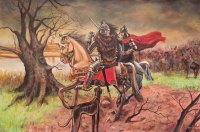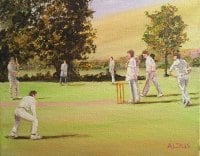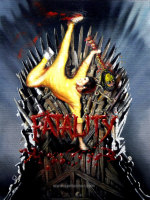Top Level > Original Paintings (6101) / Sculptures > Leon Goodman
"Chaos- Bacchante" by Leon Goodman (now sold 24/3/10)

LOVELY ORIGINAL OIL PAINTING ON CANVAS "Chaos- Bacchante" .............This beautiful rare and unusual painting is an illustration of the chaos of Bachus or Dionysus. Here Bachus the purple-stained wine god is accompanied by the Maenads, wild women flushed with wine and the Satyrs wild men with goat feet. The story of Bachus is a sad and tortured one. He was the son of Zeus but not of Zeus's wife Hera. Zeus had had a wild fling with a human girl Semele so Hera swore to kill Bachus. Poor Bachus was pursued by Hera throughout his life and became known as the thrice born having been murdered by Hera so many times then re-born. The mixture of suffering and pleasure is shown on the face of Bachus. Wine is still thought to imbue the spirit with the divine inspiration of Bachus, freeing the imbiber from mundane thoughts and conventions, altering levels of consciousness and awakening the powers of the primal self within and chaos!!!........... ...........BY THE SUPERB LEON GOODMAN WHO IS AN ACCOMPLISHED ARTIST HAVING BEEN A FINALIST AT THE GARRICK-MILNE PRIZE. HE HAS MANY OF HIS WORKS SOLD AT CHRISTIES. Measurements height 16 inches by 23 inches Oil on Canvas. .
GUARANTEED TO BE 100% ORIGINAL AND GENUINE WITH C.O.A. Leon Goodman has been a professional artist for the majority of his working life. His work has been sold at The Omell Gallery, Ascot, as well as Christies, the fine art auction house in London. Many of his works have sold for thousands of pounds to the U.S.A. Since seeing his work, Risborough Art Gallery have made him a regularly featured artist. Leon’s philosophy is that it is not the delineation of the subject which is important, but its fragmentation. He believes a strictly photographic image does not allow the viewer to participate in the painting. If the image is fragmented, the viewer can imagine for himself the missing parts and involve himself in the creation of the whole image. The viewer has seen his own interpretation of the fragmented images; the next viewer may see something different.



















































